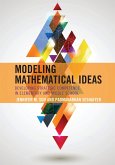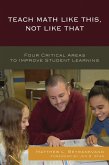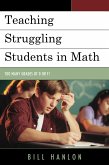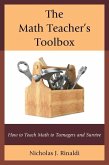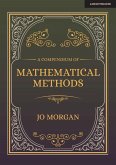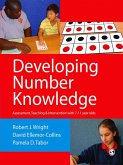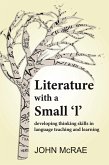Jonathan D. Katz
Developing Mathematical Thinking (eBook, ePUB)
A Guide to Rethinking the Mathematics Classroom
29,95 €
29,95 €
inkl. MwSt.
Sofort per Download lieferbar

15 °P sammeln
29,95 €
Als Download kaufen

29,95 €
inkl. MwSt.
Sofort per Download lieferbar

15 °P sammeln
Jetzt verschenken
Alle Infos zum eBook verschenken
29,95 €
inkl. MwSt.
Sofort per Download lieferbar
Alle Infos zum eBook verschenken

15 °P sammeln
Jonathan D. Katz
Developing Mathematical Thinking (eBook, ePUB)
A Guide to Rethinking the Mathematics Classroom
- Format: ePub
- Merkliste
- Auf die Merkliste
- Bewerten Bewerten
- Teilen
- Produkt teilen
- Produkterinnerung
- Produkterinnerung

Bitte loggen Sie sich zunächst in Ihr Kundenkonto ein oder registrieren Sie sich bei
bücher.de, um das eBook-Abo tolino select nutzen zu können.
Hier können Sie sich einloggen
Hier können Sie sich einloggen
Sie sind bereits eingeloggt. Klicken Sie auf 2. tolino select Abo, um fortzufahren.

Bitte loggen Sie sich zunächst in Ihr Kundenkonto ein oder registrieren Sie sich bei bücher.de, um das eBook-Abo tolino select nutzen zu können.
In this country we have done a poor job of helping students come to see the wonder, beauty and power of mathematics. Standards can be brought into the picture, but unless we think about what it means to truly engage students in mathematics we will continue to be unsuccessful. The goal of this book is to begin to change the way students experience mathematics in the middle and high school classrooms. In this book you will find a theoretical basis for this approach to teaching mathematics, multiple guides and questions for teachers to think about in relation to their everyday teaching, and over…mehr
- Geräte: eReader
- mit Kopierschutz
- eBook Hilfe
- Größe: 0.65MB
Andere Kunden interessierten sich auch für
![Modeling Mathematical Ideas (eBook, ePUB) Modeling Mathematical Ideas (eBook, ePUB)]() Jennifer M. SuhModeling Mathematical Ideas (eBook, ePUB)36,95 €
Jennifer M. SuhModeling Mathematical Ideas (eBook, ePUB)36,95 €![Teach Math Like This, Not Like That (eBook, ePUB) Teach Math Like This, Not Like That (eBook, ePUB)]() Matthew L. BeyranevandTeach Math Like This, Not Like That (eBook, ePUB)20,95 €
Matthew L. BeyranevandTeach Math Like This, Not Like That (eBook, ePUB)20,95 €![Teaching Struggling Students in Math (eBook, ePUB) Teaching Struggling Students in Math (eBook, ePUB)]() Bill HanlonTeaching Struggling Students in Math (eBook, ePUB)24,95 €
Bill HanlonTeaching Struggling Students in Math (eBook, ePUB)24,95 €![The Math Teacher's Toolbox (eBook, ePUB) The Math Teacher's Toolbox (eBook, ePUB)]() Nicholas J. RinaldiThe Math Teacher's Toolbox (eBook, ePUB)21,95 €
Nicholas J. RinaldiThe Math Teacher's Toolbox (eBook, ePUB)21,95 €![A Compendium Of Mathematical Methods: A handbook for school teachers (eBook, ePUB) A Compendium Of Mathematical Methods: A handbook for school teachers (eBook, ePUB)]() Joanne MorganA Compendium Of Mathematical Methods: A handbook for school teachers (eBook, ePUB)11,99 €
Joanne MorganA Compendium Of Mathematical Methods: A handbook for school teachers (eBook, ePUB)11,99 €![Developing Number Knowledge (eBook, ePUB) Developing Number Knowledge (eBook, ePUB)]() Robert J WrightDeveloping Number Knowledge (eBook, ePUB)36,95 €
Robert J WrightDeveloping Number Knowledge (eBook, ePUB)36,95 €![Literature with a Small 'l': Developing Thinking Skills in Language Teaching and Learning (eBook, ePUB) Literature with a Small 'l': Developing Thinking Skills in Language Teaching and Learning (eBook, ePUB)]() John McraeLiterature with a Small 'l': Developing Thinking Skills in Language Teaching and Learning (eBook, ePUB)5,99 €
John McraeLiterature with a Small 'l': Developing Thinking Skills in Language Teaching and Learning (eBook, ePUB)5,99 €-
-
-
In this country we have done a poor job of helping students come to see the wonder, beauty and power of mathematics. Standards can be brought into the picture, but unless we think about what it means to truly engage students in mathematics we will continue to be unsuccessful. The goal of this book is to begin to change the way students experience mathematics in the middle and high school classrooms. In this book you will find a theoretical basis for this approach to teaching mathematics, multiple guides and questions for teachers to think about in relation to their everyday teaching, and over 30 examples of problems, lessons, tasks, and projects that been used effectively with urban students.
Produktdetails
- Produktdetails
- Verlag: Bloomsbury eBooks US
- Seitenzahl: 150
- Erscheinungstermin: 7. Juli 2014
- Englisch
- ISBN-13: 9781475810585
- Artikelnr.: 41212567
- Verlag: Bloomsbury eBooks US
- Seitenzahl: 150
- Erscheinungstermin: 7. Juli 2014
- Englisch
- ISBN-13: 9781475810585
- Artikelnr.: 41212567
- Herstellerkennzeichnung Die Herstellerinformationen sind derzeit nicht verfügbar.
Jonathan Katz has been involved in math education a both a teacher and math coach for 33 years. He received his doctorate from Columbia University Teachers College in 2009.
Preface
Introduction
What Will You Find in This Book
Chapter 1: An Explanation of the ISA Approach to Teaching and Learning
Mathematics
Introduction
A Vision of Mathematics in an ISA Classroom
Guide To Creating a Vision and Four-Year Plan
ISA Mathematics Rubric
Indicators of Teacher Instructional Practices That Elicit Student
Mathematical Thinking
Indicators of Student Demonstration of Mathematical Thinking
Chapter 2: A Guide to Teaching and Learning Mathematics Using the Five
Dimensions of the ISA Rubric
Introduction
Dimension 1: Problem Solving
Problem Solving Definition and Overview
Teaching Idea #1: Choosing the Appropriate Problem
Teaching Idea #2A: Use Problems with Multiple Strategies
Teaching Idea #2B: Selecting an Appropriate Strategy
Teaching Idea #3: Value Process and Answer
Teaching Idea #4: Answer Student Questions to Foster Understanding
Teaching Idea #5: Error as a Tool for Inquiry
Teaching Idea #6: Students Create Their Own Problems
Dimension II: Reasoning and Proof
Reasoning and Proof Definitions and Overview
Teaching Idea #1: Conjecturing
Teaching Idea #2: Evidence and Proof
Teaching Idea #3: Metacognition
Dimension III: Communication
Communication Definition and Overview
Teaching Idea #1: Writing in Journals
Teaching Idea #2: Writing in Problems and Projects
Teaching Idea #3: Oral Communication
Dimension IV: Connections
Connections Definition and OverviewX
Teaching Idea #1: There Are Common Structures That Bind Together the
Multiple Ideas of Mathematics
Teaching Idea #2: The History of Mathematics Helps Students Make Sense of
and Appreciate Mathematics
Teaching Idea #3: Using Contextual Problems That Are Meaningful to Students
Dimension V: Representation
Representation Definition and Overview
Teaching Idea #1A: Learning to Abstract - Moving from Arithmetic to Algebra
Teaching Idea #1B: Learning to Abstract - Use Examples of Physical
Structures
Teaching Idea #2: Making Sense of Confusion to Solve Problems
Teaching Idea #3: Interpreting and Explaining
Teaching Idea #4A: Mathematical Modeling - Modeling Mathematical Ideas and
Real World Situations
Teaching Idea #4B: Mathematical Modeling - Projects of the World That Use
Rich Mathematics
Chapter 3: Problems, Investigations, Lessons, Projects, and Performance
Tasks
Introduction
Example 1: Display Dilemma Problem - Using Multiple Strategies / Looking
for Patterns
Example 2: Shakira's Number - Valuing Process
Example 3: Crossing the River - Valuing Process
Example 4: Checker Board Problem - Simplifying the Problem
Example 5: When Can I Divide? - Using Errors as a Tool of Inquiry
Example 6: Creating a Mathematical Situation: Three Examples - Students
Create Their Own Problems
Example 7: The Game of 27 - Reasoning and Conjecturing
Example 8: The String Problem - Conjecturing
Example 9: Congruence and Similarity - Conjecturing and Proof
Example 10: The Race - Metacognition on Multiple Strategies
Example 11: Murder Mystery - Evidence and Proof
Example 12: The Locker Problem - Metacognition
Example 13: Gaming the Dice - Writing in Problems
Example 14: Does Penelope Crash Into Mars? - Problems Are Meaningful to
Students
Example 15: Consecutive Sums Problem - Patterns and Conjecturing
Example 16: Activity to Lead to Definition and Multiple Representations of
a Function - Structures in Mathematics
Example 17: The Pythagorean Triplets - The History of Mathematics
Example 18: Laws of Exponents - Moving From Arithmetic to Algebra
Example 19: Working with Variables - Learning to Abstract: Moving from
Arithmetic to Algebra
Example 20: Models of the Seagram Building - Use of Physical Structures
Example 21: How Tall Is Your School Building? - Use of Physical Structures
Example 22: Model Suspension Bridge Project - Modeling Real World
Situations
Example 23: Shoe Size Problem - Modeling Real World Situations
Example 24: The Peg Game - Using Games to Understand Mathematics
Example 25: Concentration of Medication in a Patient's Blood Over Time -
Modeling Using Real World Data
Example 26: Marcella's Bagels - Working Backwards
Example 27: What is normal? - Modeling Mathematical Ideas and Real World
Situations
Example 28: Can You Build the Most Efficient Container? - Mathematical
Modeling
Example 29: Salary Choice - Mathematical Modeling
Example 30: Border Problem - Learning to Abstract: Moving from Arithmetic
to Algebra
Example 31: The Magical Exterior Angles - Encouraging the Use of Evidence
and Proof in Daily Problem Solving
Example 32: Creating a Fair Game - Projects of the World That Use Rich
Mathematics
Chapter 4: Various Guides for Teachers
Introduction
School Mathematics: A Self-Assessment
What Does An Inquiry Process Look Like In Mathematics?
How to Write an Inquiry Lesson
Questions to Think About When Planning an Inquiry-Based Common Core Aligned
Unit
List of Questions to Think About When Writing a Mathematical Performance
Task
Guide to Writing an Inquiry Lesson
Inquiry-Based Lesson Planning Template
Big Ideas in Algebra
Big Ideas in Geometry
Big Ideas in Probability and Statistics
Questions for Students to Ask Themselves When Solving a Problem
An Inquiry Approach to Look at Student Work
An Inquiry Approach to Look at a Teacher-Created Task, Activity, or Lesson
Teacher's Perceptions Continuum
Student's Perceptions Continuum
School Mathematics: A Self-Assessment
References
Introduction
What Will You Find in This Book
Chapter 1: An Explanation of the ISA Approach to Teaching and Learning
Mathematics
Introduction
A Vision of Mathematics in an ISA Classroom
Guide To Creating a Vision and Four-Year Plan
ISA Mathematics Rubric
Indicators of Teacher Instructional Practices That Elicit Student
Mathematical Thinking
Indicators of Student Demonstration of Mathematical Thinking
Chapter 2: A Guide to Teaching and Learning Mathematics Using the Five
Dimensions of the ISA Rubric
Introduction
Dimension 1: Problem Solving
Problem Solving Definition and Overview
Teaching Idea #1: Choosing the Appropriate Problem
Teaching Idea #2A: Use Problems with Multiple Strategies
Teaching Idea #2B: Selecting an Appropriate Strategy
Teaching Idea #3: Value Process and Answer
Teaching Idea #4: Answer Student Questions to Foster Understanding
Teaching Idea #5: Error as a Tool for Inquiry
Teaching Idea #6: Students Create Their Own Problems
Dimension II: Reasoning and Proof
Reasoning and Proof Definitions and Overview
Teaching Idea #1: Conjecturing
Teaching Idea #2: Evidence and Proof
Teaching Idea #3: Metacognition
Dimension III: Communication
Communication Definition and Overview
Teaching Idea #1: Writing in Journals
Teaching Idea #2: Writing in Problems and Projects
Teaching Idea #3: Oral Communication
Dimension IV: Connections
Connections Definition and OverviewX
Teaching Idea #1: There Are Common Structures That Bind Together the
Multiple Ideas of Mathematics
Teaching Idea #2: The History of Mathematics Helps Students Make Sense of
and Appreciate Mathematics
Teaching Idea #3: Using Contextual Problems That Are Meaningful to Students
Dimension V: Representation
Representation Definition and Overview
Teaching Idea #1A: Learning to Abstract - Moving from Arithmetic to Algebra
Teaching Idea #1B: Learning to Abstract - Use Examples of Physical
Structures
Teaching Idea #2: Making Sense of Confusion to Solve Problems
Teaching Idea #3: Interpreting and Explaining
Teaching Idea #4A: Mathematical Modeling - Modeling Mathematical Ideas and
Real World Situations
Teaching Idea #4B: Mathematical Modeling - Projects of the World That Use
Rich Mathematics
Chapter 3: Problems, Investigations, Lessons, Projects, and Performance
Tasks
Introduction
Example 1: Display Dilemma Problem - Using Multiple Strategies / Looking
for Patterns
Example 2: Shakira's Number - Valuing Process
Example 3: Crossing the River - Valuing Process
Example 4: Checker Board Problem - Simplifying the Problem
Example 5: When Can I Divide? - Using Errors as a Tool of Inquiry
Example 6: Creating a Mathematical Situation: Three Examples - Students
Create Their Own Problems
Example 7: The Game of 27 - Reasoning and Conjecturing
Example 8: The String Problem - Conjecturing
Example 9: Congruence and Similarity - Conjecturing and Proof
Example 10: The Race - Metacognition on Multiple Strategies
Example 11: Murder Mystery - Evidence and Proof
Example 12: The Locker Problem - Metacognition
Example 13: Gaming the Dice - Writing in Problems
Example 14: Does Penelope Crash Into Mars? - Problems Are Meaningful to
Students
Example 15: Consecutive Sums Problem - Patterns and Conjecturing
Example 16: Activity to Lead to Definition and Multiple Representations of
a Function - Structures in Mathematics
Example 17: The Pythagorean Triplets - The History of Mathematics
Example 18: Laws of Exponents - Moving From Arithmetic to Algebra
Example 19: Working with Variables - Learning to Abstract: Moving from
Arithmetic to Algebra
Example 20: Models of the Seagram Building - Use of Physical Structures
Example 21: How Tall Is Your School Building? - Use of Physical Structures
Example 22: Model Suspension Bridge Project - Modeling Real World
Situations
Example 23: Shoe Size Problem - Modeling Real World Situations
Example 24: The Peg Game - Using Games to Understand Mathematics
Example 25: Concentration of Medication in a Patient's Blood Over Time -
Modeling Using Real World Data
Example 26: Marcella's Bagels - Working Backwards
Example 27: What is normal? - Modeling Mathematical Ideas and Real World
Situations
Example 28: Can You Build the Most Efficient Container? - Mathematical
Modeling
Example 29: Salary Choice - Mathematical Modeling
Example 30: Border Problem - Learning to Abstract: Moving from Arithmetic
to Algebra
Example 31: The Magical Exterior Angles - Encouraging the Use of Evidence
and Proof in Daily Problem Solving
Example 32: Creating a Fair Game - Projects of the World That Use Rich
Mathematics
Chapter 4: Various Guides for Teachers
Introduction
School Mathematics: A Self-Assessment
What Does An Inquiry Process Look Like In Mathematics?
How to Write an Inquiry Lesson
Questions to Think About When Planning an Inquiry-Based Common Core Aligned
Unit
List of Questions to Think About When Writing a Mathematical Performance
Task
Guide to Writing an Inquiry Lesson
Inquiry-Based Lesson Planning Template
Big Ideas in Algebra
Big Ideas in Geometry
Big Ideas in Probability and Statistics
Questions for Students to Ask Themselves When Solving a Problem
An Inquiry Approach to Look at Student Work
An Inquiry Approach to Look at a Teacher-Created Task, Activity, or Lesson
Teacher's Perceptions Continuum
Student's Perceptions Continuum
School Mathematics: A Self-Assessment
References
Preface
Introduction
What Will You Find in This Book
Chapter 1: An Explanation of the ISA Approach to Teaching and Learning
Mathematics
Introduction
A Vision of Mathematics in an ISA Classroom
Guide To Creating a Vision and Four-Year Plan
ISA Mathematics Rubric
Indicators of Teacher Instructional Practices That Elicit Student
Mathematical Thinking
Indicators of Student Demonstration of Mathematical Thinking
Chapter 2: A Guide to Teaching and Learning Mathematics Using the Five
Dimensions of the ISA Rubric
Introduction
Dimension 1: Problem Solving
Problem Solving Definition and Overview
Teaching Idea #1: Choosing the Appropriate Problem
Teaching Idea #2A: Use Problems with Multiple Strategies
Teaching Idea #2B: Selecting an Appropriate Strategy
Teaching Idea #3: Value Process and Answer
Teaching Idea #4: Answer Student Questions to Foster Understanding
Teaching Idea #5: Error as a Tool for Inquiry
Teaching Idea #6: Students Create Their Own Problems
Dimension II: Reasoning and Proof
Reasoning and Proof Definitions and Overview
Teaching Idea #1: Conjecturing
Teaching Idea #2: Evidence and Proof
Teaching Idea #3: Metacognition
Dimension III: Communication
Communication Definition and Overview
Teaching Idea #1: Writing in Journals
Teaching Idea #2: Writing in Problems and Projects
Teaching Idea #3: Oral Communication
Dimension IV: Connections
Connections Definition and OverviewX
Teaching Idea #1: There Are Common Structures That Bind Together the
Multiple Ideas of Mathematics
Teaching Idea #2: The History of Mathematics Helps Students Make Sense of
and Appreciate Mathematics
Teaching Idea #3: Using Contextual Problems That Are Meaningful to Students
Dimension V: Representation
Representation Definition and Overview
Teaching Idea #1A: Learning to Abstract - Moving from Arithmetic to Algebra
Teaching Idea #1B: Learning to Abstract - Use Examples of Physical
Structures
Teaching Idea #2: Making Sense of Confusion to Solve Problems
Teaching Idea #3: Interpreting and Explaining
Teaching Idea #4A: Mathematical Modeling - Modeling Mathematical Ideas and
Real World Situations
Teaching Idea #4B: Mathematical Modeling - Projects of the World That Use
Rich Mathematics
Chapter 3: Problems, Investigations, Lessons, Projects, and Performance
Tasks
Introduction
Example 1: Display Dilemma Problem - Using Multiple Strategies / Looking
for Patterns
Example 2: Shakira's Number - Valuing Process
Example 3: Crossing the River - Valuing Process
Example 4: Checker Board Problem - Simplifying the Problem
Example 5: When Can I Divide? - Using Errors as a Tool of Inquiry
Example 6: Creating a Mathematical Situation: Three Examples - Students
Create Their Own Problems
Example 7: The Game of 27 - Reasoning and Conjecturing
Example 8: The String Problem - Conjecturing
Example 9: Congruence and Similarity - Conjecturing and Proof
Example 10: The Race - Metacognition on Multiple Strategies
Example 11: Murder Mystery - Evidence and Proof
Example 12: The Locker Problem - Metacognition
Example 13: Gaming the Dice - Writing in Problems
Example 14: Does Penelope Crash Into Mars? - Problems Are Meaningful to
Students
Example 15: Consecutive Sums Problem - Patterns and Conjecturing
Example 16: Activity to Lead to Definition and Multiple Representations of
a Function - Structures in Mathematics
Example 17: The Pythagorean Triplets - The History of Mathematics
Example 18: Laws of Exponents - Moving From Arithmetic to Algebra
Example 19: Working with Variables - Learning to Abstract: Moving from
Arithmetic to Algebra
Example 20: Models of the Seagram Building - Use of Physical Structures
Example 21: How Tall Is Your School Building? - Use of Physical Structures
Example 22: Model Suspension Bridge Project - Modeling Real World
Situations
Example 23: Shoe Size Problem - Modeling Real World Situations
Example 24: The Peg Game - Using Games to Understand Mathematics
Example 25: Concentration of Medication in a Patient's Blood Over Time -
Modeling Using Real World Data
Example 26: Marcella's Bagels - Working Backwards
Example 27: What is normal? - Modeling Mathematical Ideas and Real World
Situations
Example 28: Can You Build the Most Efficient Container? - Mathematical
Modeling
Example 29: Salary Choice - Mathematical Modeling
Example 30: Border Problem - Learning to Abstract: Moving from Arithmetic
to Algebra
Example 31: The Magical Exterior Angles - Encouraging the Use of Evidence
and Proof in Daily Problem Solving
Example 32: Creating a Fair Game - Projects of the World That Use Rich
Mathematics
Chapter 4: Various Guides for Teachers
Introduction
School Mathematics: A Self-Assessment
What Does An Inquiry Process Look Like In Mathematics?
How to Write an Inquiry Lesson
Questions to Think About When Planning an Inquiry-Based Common Core Aligned
Unit
List of Questions to Think About When Writing a Mathematical Performance
Task
Guide to Writing an Inquiry Lesson
Inquiry-Based Lesson Planning Template
Big Ideas in Algebra
Big Ideas in Geometry
Big Ideas in Probability and Statistics
Questions for Students to Ask Themselves When Solving a Problem
An Inquiry Approach to Look at Student Work
An Inquiry Approach to Look at a Teacher-Created Task, Activity, or Lesson
Teacher's Perceptions Continuum
Student's Perceptions Continuum
School Mathematics: A Self-Assessment
References
Introduction
What Will You Find in This Book
Chapter 1: An Explanation of the ISA Approach to Teaching and Learning
Mathematics
Introduction
A Vision of Mathematics in an ISA Classroom
Guide To Creating a Vision and Four-Year Plan
ISA Mathematics Rubric
Indicators of Teacher Instructional Practices That Elicit Student
Mathematical Thinking
Indicators of Student Demonstration of Mathematical Thinking
Chapter 2: A Guide to Teaching and Learning Mathematics Using the Five
Dimensions of the ISA Rubric
Introduction
Dimension 1: Problem Solving
Problem Solving Definition and Overview
Teaching Idea #1: Choosing the Appropriate Problem
Teaching Idea #2A: Use Problems with Multiple Strategies
Teaching Idea #2B: Selecting an Appropriate Strategy
Teaching Idea #3: Value Process and Answer
Teaching Idea #4: Answer Student Questions to Foster Understanding
Teaching Idea #5: Error as a Tool for Inquiry
Teaching Idea #6: Students Create Their Own Problems
Dimension II: Reasoning and Proof
Reasoning and Proof Definitions and Overview
Teaching Idea #1: Conjecturing
Teaching Idea #2: Evidence and Proof
Teaching Idea #3: Metacognition
Dimension III: Communication
Communication Definition and Overview
Teaching Idea #1: Writing in Journals
Teaching Idea #2: Writing in Problems and Projects
Teaching Idea #3: Oral Communication
Dimension IV: Connections
Connections Definition and OverviewX
Teaching Idea #1: There Are Common Structures That Bind Together the
Multiple Ideas of Mathematics
Teaching Idea #2: The History of Mathematics Helps Students Make Sense of
and Appreciate Mathematics
Teaching Idea #3: Using Contextual Problems That Are Meaningful to Students
Dimension V: Representation
Representation Definition and Overview
Teaching Idea #1A: Learning to Abstract - Moving from Arithmetic to Algebra
Teaching Idea #1B: Learning to Abstract - Use Examples of Physical
Structures
Teaching Idea #2: Making Sense of Confusion to Solve Problems
Teaching Idea #3: Interpreting and Explaining
Teaching Idea #4A: Mathematical Modeling - Modeling Mathematical Ideas and
Real World Situations
Teaching Idea #4B: Mathematical Modeling - Projects of the World That Use
Rich Mathematics
Chapter 3: Problems, Investigations, Lessons, Projects, and Performance
Tasks
Introduction
Example 1: Display Dilemma Problem - Using Multiple Strategies / Looking
for Patterns
Example 2: Shakira's Number - Valuing Process
Example 3: Crossing the River - Valuing Process
Example 4: Checker Board Problem - Simplifying the Problem
Example 5: When Can I Divide? - Using Errors as a Tool of Inquiry
Example 6: Creating a Mathematical Situation: Three Examples - Students
Create Their Own Problems
Example 7: The Game of 27 - Reasoning and Conjecturing
Example 8: The String Problem - Conjecturing
Example 9: Congruence and Similarity - Conjecturing and Proof
Example 10: The Race - Metacognition on Multiple Strategies
Example 11: Murder Mystery - Evidence and Proof
Example 12: The Locker Problem - Metacognition
Example 13: Gaming the Dice - Writing in Problems
Example 14: Does Penelope Crash Into Mars? - Problems Are Meaningful to
Students
Example 15: Consecutive Sums Problem - Patterns and Conjecturing
Example 16: Activity to Lead to Definition and Multiple Representations of
a Function - Structures in Mathematics
Example 17: The Pythagorean Triplets - The History of Mathematics
Example 18: Laws of Exponents - Moving From Arithmetic to Algebra
Example 19: Working with Variables - Learning to Abstract: Moving from
Arithmetic to Algebra
Example 20: Models of the Seagram Building - Use of Physical Structures
Example 21: How Tall Is Your School Building? - Use of Physical Structures
Example 22: Model Suspension Bridge Project - Modeling Real World
Situations
Example 23: Shoe Size Problem - Modeling Real World Situations
Example 24: The Peg Game - Using Games to Understand Mathematics
Example 25: Concentration of Medication in a Patient's Blood Over Time -
Modeling Using Real World Data
Example 26: Marcella's Bagels - Working Backwards
Example 27: What is normal? - Modeling Mathematical Ideas and Real World
Situations
Example 28: Can You Build the Most Efficient Container? - Mathematical
Modeling
Example 29: Salary Choice - Mathematical Modeling
Example 30: Border Problem - Learning to Abstract: Moving from Arithmetic
to Algebra
Example 31: The Magical Exterior Angles - Encouraging the Use of Evidence
and Proof in Daily Problem Solving
Example 32: Creating a Fair Game - Projects of the World That Use Rich
Mathematics
Chapter 4: Various Guides for Teachers
Introduction
School Mathematics: A Self-Assessment
What Does An Inquiry Process Look Like In Mathematics?
How to Write an Inquiry Lesson
Questions to Think About When Planning an Inquiry-Based Common Core Aligned
Unit
List of Questions to Think About When Writing a Mathematical Performance
Task
Guide to Writing an Inquiry Lesson
Inquiry-Based Lesson Planning Template
Big Ideas in Algebra
Big Ideas in Geometry
Big Ideas in Probability and Statistics
Questions for Students to Ask Themselves When Solving a Problem
An Inquiry Approach to Look at Student Work
An Inquiry Approach to Look at a Teacher-Created Task, Activity, or Lesson
Teacher's Perceptions Continuum
Student's Perceptions Continuum
School Mathematics: A Self-Assessment
References

